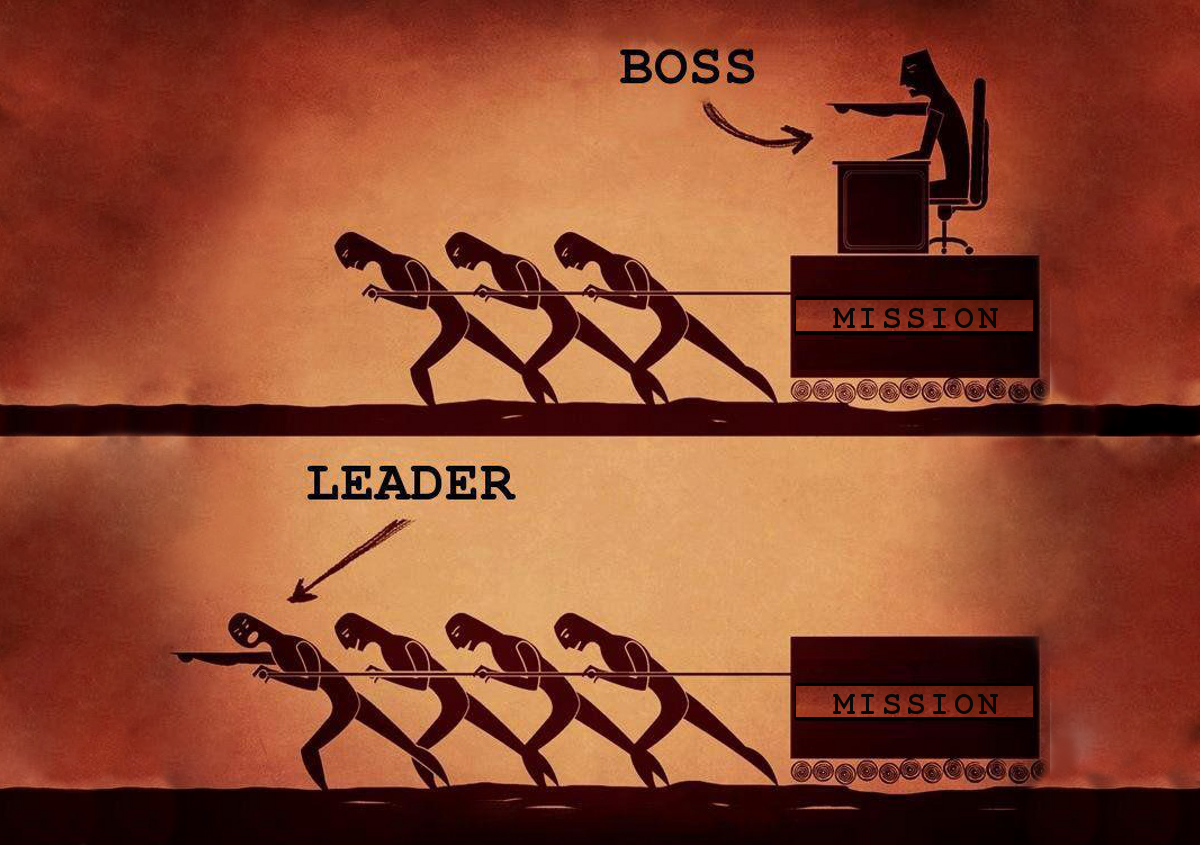If you look up the definition of mindset you will find several concepts that are relevant to leadership mindset training:
1. “The established set of attitudes held by someone” (Google)
2. “A fixed mental attitude or disposition that predetermines a person’s responses to and interpretations of situations—an inclination or a habit.” (Dictionary.com)
3. “A person’s way of thinking and their opinions” (Cambridge English Dictionary)
In the chart below, I have listed the characteristics of awful versus awesome leaders in terms of their leadership mindset. For context, I will share several philosophical underpinnings about leadership that I believe to be true. In short, awesome leaders are distinguished from awful leaders by their growth mindset, their role in unlocking the potential of individuals and teams whom they serve, and their orientation toward taking action to create results. After the chart, I discuss the mirror effect and provide an exercise to help you take action to become the kind of leader you want to be. First, let’s dive a bit deeper into these philosophical understandings.
Fixed versus Growth Mindset
Awful leaders are not even willing to try. They’ve essentially given up on themselves because somewhere along their journey they have been convinced that they can’t change or they won’t change. Awesome leaders are in a constant state of learning and look at others as learning opportunities. They know they won’t always get it right, but they’ll figure it out and make it right. One of the experts (and pioneers) on Fixed vs Growth mindsets is Stanford University psychologist, Carol Dweck, and here’s how she summarizes the differences:
“In a fixed mindset, students believe their basic abilities, their intelligence, their talents, are just fixed traits. They have a certain amount and that’s that, and then their goal becomes to look smart all the time and never look dumb. In a growth mindset, students understand that their talents and abilities can be developed through effort, good teaching, and persistence. They don’t necessarily think everyone’s the same or anyone can be Einstein, but they believe everyone can get smarter if they work at it.”
Leaders Aren’t Born, They’re Made
Each of us has untapped potential, and I wouldn’t be spending the time I do on sharing my thoughts, observations, and lessons learned if I didn’t believe that anyone can become a better leader. It’s up to us to figure out how to use our natural talent, gift, and untapped potential, but most of us (this definitely includes me) need help from others to realize our potential. Awesome leaders understand this and know that part of their job is helping others unlock their potential. By doing so, they not only build immense trust with those they help, but they also make their team that much better. Another less obvious action occurs when you help others become better—you become better too.
Leaders Take Action to Deliver Results
Above all else, a foremost tenet of awesome leadership is that leaders take action. Taking action is the difference-maker in both life and leading, and everything else is just talk, thoughts, or a host of excuses. Wayne Gretsky once said, “You’ll miss 100% of the shots you don’t take.” If you don’t take action, you are guaranteed not to get the results you’re looking for. Too many of us either get analysis-paralysis or find excuses for not taking the actions that matter. No action means no results, and that’s not an acceptable outcome for you or for your teammates.
Make no mistake, you can be the best, most charismatic, inspirational, goal-oriented leader in the world, but at the end of the day, you’ll be judged on the results your teams deliver. And for your teams to deliver, they need to believe in you, trust you, and want to help you and the team. Humans are complicated, and we’re all different (for better and for worse), but one thing is clear: people respond more positively to other people when they truly believe you care about them, their well being, and their future success. That’s what I hope you’ll take away from this article and this is what powers me to be a prominent and high energy business leadership speaker.
Leadership Mindsets of Awful vs Awesome Leaders
The idea behind the chart is to reflect, remind, and retool our mindsets to be better leaders. Mindsets develop behaviors, and behaviors drive actions to create results. Of course, the key elements to focus on are building the correct behaviors for the desired results. In an effort to help you (and me) consolidate a list of helpful mindsets that will build the behaviors for awesome leadership results, I’ve assembled what I call “The A&A Chart.” On the left are the attitudes and actions associated with awful leadership, and on the right are mindsets and behaviors connected to awesome leaders.
Awful |
Awesome |
| People are there to serve the leader | Leader’s purpose is to serve people |
| People work FOR the leadership | Leaders work WITH people |
| When things go right, it’s because of leadership | When things go right, it’s because of the team’s effort |
| When things go wrong, it’s because of them | When things go wrong, it’s on the leader’s shoulders |
| Quick to place and announce blame, and slow to understand the root cause of the failure | Focused on understanding what failed and why, and quick to communicate the reasons for failure |
| Makes people come to his/her office | Goes to people’s place of work to have discussions |
| Time is too valuable to communicate, except by email | Places value on one-on-one and one-on-many face-to-face communication |
| Believes actions outside of work don’t matter, and maintains two different personas | Knows there’s no magical wall between actions at work and outside of work, and strives to maintain one authentic persona |
| Views people as resources that require managing, in much the same regard as time and money | Believes people don’t want to be managed, and that they want to lead, learn, and excel |
| Only shares information on a need-to-know basis | Communicates with context, and continually communicates information for all to know |
| Believes information is for senior executives only | Believes that the more people know, the more they can help the team |
| Thinks that the best ideas come from senior people | Knows that great ideas can come from everyone |
| Used hierarchy to distance themselves from others | Though their organization may have a hierarchical structure, they practice a flat hierarchy of sharing information and making access to themselves easier |
| Continually reminds people to do their jobs and only their jobs | Continually reminds people that ideas, process improvements, and feedback are everyone’s responsibility |
| Thinks he/she is the smartest person in the room because they’re the boss | Knows that they are not the smartest person in the room |
| Looks at employees as burdens | Views people as a privilege to work with |
| Thinks money is the main motivator to get things done | Ties elements of financial, purpose, passion, and personal/team recognition to drive results |
| Views people as employees who are lucky to work for the leader | Views people as volunteers who have made a choice to work with the leader |
| Proud of being called a boss who burns out “his” or “her” people | Knows that there are times that will require immense effort, but looks for balance over the long term |
| Thinks people who take vacations are weak, and likes to remind others of the last time he or she ever took a vacation | Encourages people to take time off to recharge, and knows that people are more productive with a happy life outside of work |
| Is married to his or her work, and puts everything else as secondary to it | Works hard and plays hard |
Leadership Mindset Training: The Mirror Effect
Now that we have a more thorough understanding of the differences between awful and awesome leadership, let’s move on to an exercise to help you take action to become the kind of leader you want to be—I base this exercise on The Mirror Effect. Psychologists use a term called “mirroring” or the “mirroring effect” to describe how people reflect the behavior of others, including speech patterns, gestures, and attitudes, especially if they are influential people in our lives. Individuals are likely to mirror a person of higher status or power, which may create an illusion of higher status, or create rapport with the individual in power. Mirroring may allow the person to gain favor with the individual in power, and can be a useful tool for individuals requesting promotions, asking for favors, and seeking some benefit from the person in power. A lot of mirroring is likely happening naturally on its own, but the goal is not to copy or manipulate, but rather to build rapport and amplify someone’s connection to you. When you want to be more effective, try being more reflective.
Awesome leaders strive to be self-aware and recognize their power to influence (for the good or otherwise) the attitudes and behaviors of people in their sphere of influence. Actions speak louder than your words, and leaders set the tone for everything that happens on their team. The actions you take are up to you, and you are in charge of your thoughts, emotions, attitudes, and behaviors. Thus, you decide what kind of leader you want to be. For this exercise, pick any one of those actions on the Awful & Awesome Chart that you want to learn, change, grow, or improve. Find others to emulate and replicate their actions, reflecting the best of what you see in others, starting with simple mirrored reflections of gestures, phrases, and expressions. You can even go so far as to tell your teammates that you’re working on your leadership skills, and invite them to hold up a mirror for you. It’s called good old honest, candid feedback, not the “rose tinted glasses” variety! Show them you’re trying, and guess what will happen? They’ll try too! And while you’re trying to improve your ability to serve them, they will mirror your actions and work to serve you by offering you advice. It’s a spiral of good actions that will lead you and your teammates to find success together.
Looking for more help to become the kind of leader you want to be? In addition to Be Unstoppable and Unstoppable Teams, BE UNSTOPPABLE Products and BE UNSTOPPABLE Courses can help you on your path to success. It is our mission to help you acquire not just the tools you need to survive uncertain times and adversity, but also to develop the mindset and actions required to thrive and accomplish more than you originally thought possible. Now, go challenge yourself!





